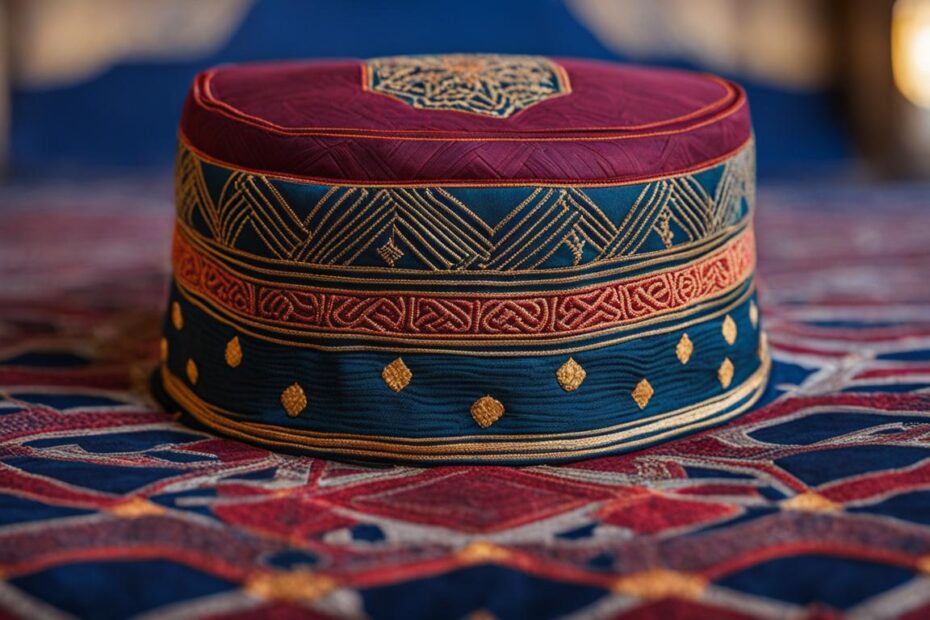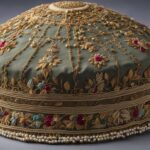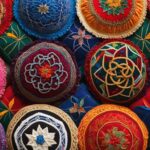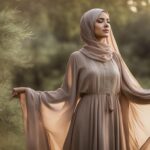The Prayer Cap (Kufi) is a timeless symbol of tradition and style in the Muslim community. It is worn by individuals seeking to express their religious devotion and cultural heritage. The cap is available in various styles and designs, including Islamic caps and traditional Muslim caps.
Key Takeaways:
- The Prayer Cap (Kufi) is an essential prayer tool in the Muslim community.
- It symbolizes religious devotion, cultural heritage, and personal style.
- Prayer caps are worn during worship to symbolize humility and reverence.
- There are variations in style and design among different sects.
- Prayer caps are made using materials like cotton, polyester, and blends.
The Significance of Prayer Caps in Muslim Practices
Prayer caps hold immense significance in Muslim practices as they serve as a visual representation of humility and reverence during prayers. These caps, also known as Kufis, are worn by both men and women to create a spiritual connection with their faith and to focus their minds during worship. By wearing a prayer cap, individuals demonstrate their dedication to their religious beliefs and their commitment to submitting to a higher power.
Aside from their symbolic meaning, prayer caps also serve a practical purpose in Muslim prayers. They help to create a sense of focus and concentration by enveloping the head and minimizing distractions. The cap acts as a physical reminder to the wearer that they are entering a sacred space and engaging in a ritual of worship. It helps to establish a dedicated mindset and aids in blocking out worldly concerns, allowing individuals to fully immerse themselves in their prayers.
Prayer caps are considered one of the essential prayer tools for Muslims. Alongside other tools such as prayer beads (misbaha) and prayer rugs (sajjadah), they form an integral part of the spiritual practice. These tools collectively guide and enhance the prayer experience, facilitating a deeper connection with Allah. By incorporating prayer caps into their rituals, Muslims find solace in the familiarity and consistency of these practices, fostering a deeper sense of devotion and spirituality.
Overall, prayer caps hold profound significance in Muslim practices. They not only symbolize humility and devotion but also serve as a practical tool to enhance the prayer experience. By donning a prayer cap, individuals are able to express their religious identity, focus their minds, and establish a sacred space for connection with Allah.
Variations in Prayer Caps Among Sects
Prayer caps, also known as Kufis, hold great significance in the Muslim community. While they serve as a common symbol of religious devotion and cultural heritage, there are variations in their style and design among different sects. These variations reflect the diverse traditions and practices within the Muslim community.
Variations in Style and Design
Within the Muslim community, different sects have developed their own preferences when it comes to prayer caps. Some sects favor simple and plain caps, emphasizing modesty and humility. Others embrace more elaborate designs, featuring intricate embroidery and patterns. These variations in style and design allow individuals to express their identity and affiliation with their respective sects.
Cultural Significance
The differences in prayer cap styles also highlight the cultural diversity within the Muslim community. Certain caps may be associated with specific regions or communities, representing their cultural heritage and customs. Wearing a prayer cap not only serves a religious purpose but also acts as a statement of cultural pride and identity.
Respectful Coexistence
Despite the variations in prayer caps, it is essential to note that the Muslim community places a strong emphasis on unity and respect among different sects. While individuals may wear different styles of caps, the underlying purpose remains the same – to connect with their faith and demonstrate devotion to Allah.
| Sect | Cap Style | Cultural Significance |
|---|---|---|
| Sunni | Simple and plain caps | Focus on modesty and humility |
| Shia | Elaborate designs with embroidery and patterns | Represent cultural heritage and customs |
| Sufi | Variety of styles, including tasseled caps | Symbolize spiritual devotion |

As with many aspects of religious practice, the variations in prayer caps reflect the rich diversity within the Muslim community. These differences are embraced and respected, allowing individuals to express their uniqueness while maintaining a sense of unity among believers.
The Materials Used for Prayer Caps
Prayer caps, also known as Kufis, are crafted using a variety of materials that offer comfort, durability, and aesthetic appeal. These materials are carefully chosen to ensure that prayer caps serve their purpose while adding a touch of style to the wearer’s attire.
Cotton is a popular choice for prayer caps due to its softness and breathability. It is a natural fabric that allows air to circulate, keeping the head cool during prayers. Cotton prayer caps come in various colors and designs, making them versatile options for different occasions.
Polyester is another commonly used material for prayer caps. It is a synthetic fabric that offers durability and easy maintenance. Polyester caps are often lightweight and resistant to wrinkling, ensuring that they retain their shape and appearance over time.
“The choice of material for a prayer cap depends on the individual’s preferences. Some may prefer the softness of cotton, while others may prioritize the durability of polyester. Ultimately, it is important to choose a material that feels comfortable and aligns with one’s personal style.”
In addition to cotton and polyester, prayer caps are sometimes made from blends of these fabrics, combining the desired properties of both materials. These blended caps offer the best of both worlds, providing comfort and longevity.
| Material | Features | Examples |
|---|---|---|
| Cotton | Soft, breathable, versatile | Cotton Kufis with intricate embroidery |
| Polyester | Durable, wrinkle-resistant | Polyester prayer caps with modern designs |
| Blend | Combination of comfort and longevity | Kufis made from cotton-polyester blends |
Evolution of Prayer Caps Over Time
Prayer caps, also known as Kufis, have undergone significant changes in style and design over the years. From simple and modest caps to intricate and embellished ones, the evolution of prayer caps reflects the influence of fashion trends and cultural shifts within the Muslim community.
Traditionally, prayer caps were plain and unadorned, symbolizing humility and modesty. However, as fashion preferences evolved, so did the design of prayer caps. Today, prayer caps come in a wide variety of styles, colors, and patterns, allowing individuals to express their personal taste and fashion sense while maintaining a connection to their religious traditions.
The incorporation of intricate embroidery, lacework, and embellishments into prayer caps has become increasingly popular in recent years. These design elements not only add aesthetic appeal but also showcase the artistry and craftsmanship of the cap makers. From delicate floral patterns to geometric motifs, these embellishments create visually stunning prayer caps that are both unique and captivating.
The Evolution of Prayer Caps
| Time Period | Style | Design |
|---|---|---|
| Traditional | Simple and Modest | Plain fabric, no embellishments |
| Modern | Versatile | Various colors, patterns, and designs |
| Contemporary | Intricate and Embellished | Embroidery, lacework, and embellishments |
The evolution of prayer caps over time not only reflects changing fashion trends but also the desire of individuals to incorporate their personal style into their religious practices. It is a testament to the adaptability and innovation within the Muslim community, as they find new ways to express their faith and cultural identity through their choice of prayer caps.
Lesser-Known Prayer Caps
While the Prayer Cap (Kufi) is a well-known symbol of tradition and style in the Muslim community, there are lesser-known prayer caps that showcase the diverse cultural traditions within the Muslim world. These unique caps are often specific to certain regions or communities, providing individuals with the opportunity to express their identity and heritage through their headwear.
One example of a lesser-known prayer cap is the Moroccan Fez. Originating from Morocco, this cap is distinguishable by its conical shape and vibrant colors. It is often adorned with decorative tassels, showcasing the rich cultural heritage of Morocco.
Another lesser-known prayer cap is the Afghan Pakol. This cap hails from Afghanistan and is made from wool, providing warmth in colder climates. It has a distinctive design with a round shape and a rolled-up brim, representing the traditional headwear of Afghan communities.
It is important to recognize and appreciate these lesser-known prayer caps as they contribute to the cultural tapestry of the Muslim world. By embracing and wearing these unique caps, individuals can celebrate their heritage and express their individuality within their faith.
The Artistry of Handcrafted Prayer Caps
Handcrafted prayer caps are a testament to the artistry and craftsmanship within the Muslim community. These caps are meticulously created by skilled artisans, resulting in unique and authentic pieces that showcase the cultural traditions and attention to detail. Handcrafted prayer caps add a touch of elegance and personalization to the act of prayer, allowing individuals to connect with their faith in a meaningful way.
One of the key characteristics of handcrafted prayer caps is the use of high-quality materials. Artisans often select premium fabrics such as silk, velvet, or fine cotton to create a luxurious feel and appearance. The use of intricate embroidery, delicate lace, or traditional patterns further enhances the beauty and aesthetics of these caps.
“Handcrafted prayer caps are not only religious accessories but also works of art that reflect the rich history and cultural heritage of the Muslim community. Each cap is a labor of love, and the craftsmanship involved in their creation is truly remarkable.”
Handcrafted caps also allow for customization and personalization. Individuals can choose specific colors, designs, or even request their names or initials to be added to the caps. This level of customization ensures that each cap is unique and tailored to the wearer’s preferences.
The Beauty of Handcrafted Prayer Caps
When it comes to handcrafted prayer caps, every detail matters. From the stitching to the embroidery, each cap is carefully crafted to perfection. The level of skill and artistry involved in the creation of these caps is truly remarkable.
The intricate designs and patterns on handcrafted caps often hold symbolic meaning. They can represent cultural motifs, religious symbols, or geometric patterns that have been passed down through generations. These designs not only add beauty to the caps but also serve as a visual reminder of the wearer’s connection to their faith and heritage.
Overall, handcrafted prayer caps are not just ordinary headwear. They are an expression of devotion, cultural identity, and artistry. With their unique designs and meticulous craftsmanship, these caps are a testament to the rich traditions and craftsmanship within the Muslim community.

The Role of Prayer Caps in Personal Style
Prayer caps, also known as Kufis or Islamic caps, not only serve a religious purpose but also allow individuals to manifest their personal style. These caps, worn by Muslims during prayers, offer a unique opportunity for self-expression. With a wide range of designs, colors, and patterns available, individuals can choose a prayer cap that aligns with their aesthetic preferences and complements their overall look.

Prayer caps come in various styles, ranging from simple and modest designs to intricately embroidered and embellished caps. Some individuals prefer plain caps that blend seamlessly with their everyday attire, while others opt for more decorative caps that make a bold fashion statement. The versatility of prayer caps allows individuals to customize their look while still adhering to religious and cultural traditions.
By incorporating a prayer cap into their personal style, individuals can showcase their devotion to their faith and cultural heritage. The cap becomes a symbol of identity, representing their connection to the Muslim community and their commitment to religious practices. It is a tangible expression of faith that carries deep personal significance for many Muslims.
Variety in Prayer Cap Styles
Table: Comparison of different prayer cap styles
| Style | Description |
|---|---|
| Plain Caps | Simple and minimalistic designs without any embellishments. |
| Embroidered Caps | Caps featuring intricate embroidery or patterns, adding a touch of elegance and sophistication. |
| Colorful Caps | Caps available in a wide range of vibrant colors, allowing individuals to make a bold fashion statement. |
| Unique Materials | Caps crafted from unconventional materials such as leather or silk, adding a distinctive flair. |
| Traditional Caps | Caps that adhere to specific cultural traditions or regional styles, showcasing cultural heritage. |
Whether it’s a simple cap that blends seamlessly with everyday attire or an elaborate cap that makes a fashion statement, prayer caps play a significant role in personal style for many Muslims. They allow individuals to express their identity, cultural heritage, and religious devotion while also showcasing their unique fashion sense.
The Cultural Significance of Prayer Caps
Prayer caps, also known as Kufis, hold immense cultural significance within the Muslim community. Beyond their religious symbolism, these caps are often associated with specific regions, communities, or cultural practices, representing cultural heritage and identity. Wearing a prayer cap is not only a way to express religious devotion but also to honor and preserve cultural traditions.
The practice of wearing prayer caps varies across different Muslim communities and regions. In some cultures, the cap is an essential part of daily attire, representing a deep connection to faith and community. The cap serves as a visible symbol of a person’s religious identity, demonstrating their commitment to Islamic values.
“The prayer cap is more than just a piece of clothing. It is a way for us to connect with our heritage, our ancestors, and our roots.” – Mohammad Ali, a member of the local Muslim community.
Furthermore, prayer caps can help foster a sense of unity and pride among Muslims. By wearing a cap that is specific to their culture or community, individuals can proudly display their heritage and strengthen their sense of belonging. The prayer cap serves as a reminder of the rich cultural diversity within the Muslim world.
Overall, the cultural significance of prayer caps goes beyond their religious and practical functions. They are symbols of cultural identity, regional traditions, and personal pride. Whether simple or intricately designed, prayer caps represent the heritage and values of the wearers, allowing them to connect with their cultural roots while expressing their devotion to Islam.
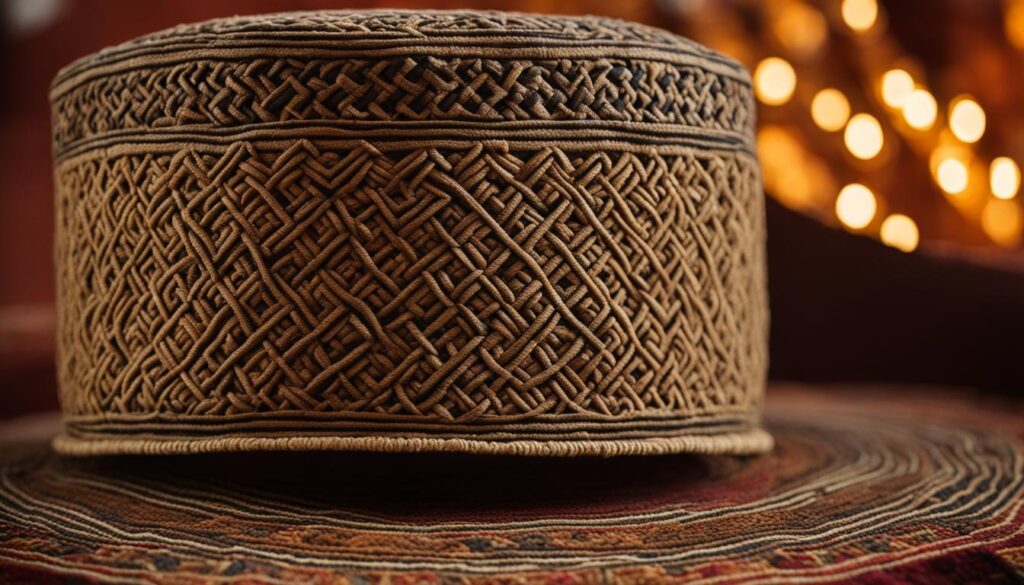
Exploring Unique Prayer Caps
“Fashion is a form of self-expression.”
– Unknown
Prayer caps, also known as Kufis or Islamic caps, have long been an integral part of Muslim headwear. While traditional prayer caps have a simple and modest design, there are unique variations available that cater to individual preferences. These unique caps often feature distinct patterns, colors, or materials, allowing individuals to stand out and express their individuality.
One example of a unique prayer cap is the “Ottoman-style embroidered Kufi”. This cap is inspired by the rich cultural heritage of the Ottoman Empire and showcases intricate embroidery with vibrant colors. It is a testament to the craftsmanship and attention to detail that goes into creating these headwear pieces.
Another popular variation is the “Handwoven Moroccan Kufi”. These caps are meticulously handcrafted by skilled artisans using traditional weaving techniques. They feature intricate patterns and often incorporate vibrant colors and unique textures. Wearing a handwoven Moroccan Kufi is not only a way to express one’s personal style but also a celebration of the diversity and artistry of Moroccan culture.
For those who prefer a modern twist to their prayer caps, there are caps available with contemporary designs and materials. The “Stylish Fabric-Blend Kufi” combines the comfort of breathable fabrics with trendy patterns. These caps often feature a blend of materials like cotton and polyester, offering a comfortable fit while still making a fashion statement.
| Unique Prayer Cap | Description |
|---|---|
| Ottoman-style embroidered Kufi | Inspired by the rich cultural heritage of the Ottoman Empire, this cap features intricate embroidery and vibrant colors. |
| Handwoven Moroccan Kufi | Meticulously handcrafted using traditional weaving techniques, these caps showcase intricate patterns and vibrant colors. |
| Stylish Fabric-Blend Kufi | A modern twist on the traditional cap, combining comfort and trendy patterns with a blend of cotton and polyester fabrics. |
Whether it’s embracing the cultural traditions of the Ottoman Empire, celebrating the artistry of Moroccan craftsmanship, or adding a contemporary touch to one’s prayer attire, unique prayer caps provide individuals with the opportunity to express their individuality and make a statement with their headwear. These caps not only serve a functional purpose during prayers but also serve as a reflection of personal style and cultural heritage.
Next time you’re looking for a prayer cap, consider exploring the world of unique caps and find one that truly resonates with your sense of style and identity.
Finding the Perfect Prayer Cap
When it comes to finding the perfect prayer cap (Kufi) that suits your style and religious beliefs, there are a few factors to consider. The prayer cap is not only an essential prayer tool for Muslims but also a way to express cultural heritage and personal identity. With a wide variety of designs, materials, and styles available, you have the opportunity to find a cap that resonates with you.
First, think about the purpose of the cap. Are you looking for a simple and traditional design or something more unique and eye-catching? Consider the occasions and settings in which you plan to wear the cap and choose a style that reflects your preferences. Some individuals prefer plain caps made of cotton for everyday use, while others opt for more elaborate designs with embroidered patterns for special occasions.
Next, explore the materials used for prayer caps. Cotton and polyester are common choices due to their comfort and durability. Consider your climate and personal preference for texture when selecting a material. Additionally, some caps feature lace or embroidery for added aesthetic appeal. Take into account the maintenance required for each material and make a choice that suits your lifestyle.
Table: Comparison of Materials
| Material | Comfort | Durability | Aesthetic Appeal |
|---|---|---|---|
| Cotton | High | Moderate | Plain |
| Polyester | Moderate | High | Plain |
| Blend | High | High | Plain or Embroidered |
Lastly, consider the cultural significance of the cap. Different regions and communities may have their own unique styles and designs. Research the cultural traditions associated with prayer caps to gain a deeper understanding of their symbolic value. By selecting a cap that aligns with your cultural background, you can honor and preserve these traditions.
Ultimately, finding the perfect prayer cap is a personal journey. Take your time exploring different options, consulting with trusted sources, and considering the factors that matter most to you. Whether you choose a traditional or a more contemporary design, the prayer cap will serve as a meaningful accessory that reflects your faith and personal style.
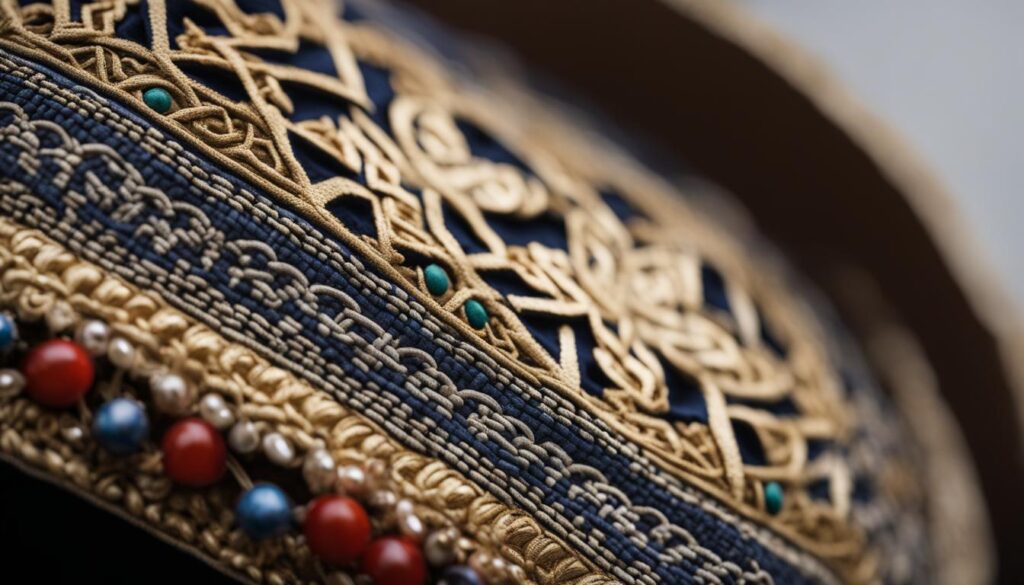
Conclusion
The Prayer Cap (Kufi) is a significant accessory in the Muslim community, symbolizing religious devotion, cultural heritage, and personal style. It is one of the main prayer tools used by Muslims to connect with their faith and focus their minds during worship. The cap represents humility and reverence, and its timeless design has evolved over time to reflect changing fashion trends and cultural influences.
There are variations in prayer caps among different sects within the Muslim community. Some prefer simple and plain caps, while others embrace embroidered designs and patterns. These variations highlight the diverse cultural traditions within the Muslim world and allow individuals to express their identity and heritage through their headwear.
Prayer caps are made using a variety of materials, including cotton, polyester, and blends of these fabrics. The choice of material depends on factors such as comfort, durability, and aesthetic appeal. Designs can also feature additional elements like lace and embroidery, showcasing the artistry and craftsmanship of traditional headwear.
In addition to traditional prayer caps, there are unique variations available that cater to individual preferences. These unique caps often feature distinct patterns, colors, or materials, allowing individuals to stand out and express their individuality. Finding the perfect prayer cap is an exciting journey, as individuals can explore different styles, materials, and designs to find one that resonates with their personal taste and cultural background.
FAQ
What is the significance of wearing a prayer cap?
The prayer cap symbolizes humility and reverence during prayers and is considered one of the essential prayer tools for Muslims.
Do both men and women wear prayer caps?
Yes, prayer caps are worn by both men and women as a way to connect with their faith and focus their minds during worship.
Are there variations in prayer caps among different sects within the Muslim community?
Yes, some sects prefer simple and plain caps, while others embrace embroidered designs and patterns, reflecting the cultural diversity within the Muslim community.
What materials are used to make prayer caps?
Prayer caps are made using a variety of materials, including cotton, polyester, and blends of these fabrics, depending on factors such as comfort, durability, and aesthetic appeal.
How have the style and design of prayer caps evolved over time?
While traditional caps have a simple and modest design, modern caps often incorporate intricate patterns, embroidery, and embellishments, reflecting changing fashion trends and cultural influences.
Are there lesser-known prayer caps unique to specific regions or communities?
Yes, there are lesser-known prayer caps that showcase the diverse cultural traditions within the Muslim world, allowing individuals to express their identity and heritage through their headwear.
Are handcrafted prayer caps available?
Yes, many prayer caps are meticulously handcrafted, showcasing the artistry and craftsmanship of traditional headwear and offering a unique and authentic piece.
Can prayer caps be a way to express personal style?
Yes, prayer caps not only serve a religious purpose but also allow individuals to manifest their personal style. With a wide range of designs, colors, and patterns available, individuals can choose a prayer cap that aligns with their aesthetic preferences.
Do prayer caps hold cultural significance?
Yes, prayer caps are often associated with specific regions, communities, or cultural practices, representing cultural heritage and identity. Wearing a prayer cap can be a way to honor and preserve cultural traditions.
Are there unique variations of prayer caps available?
Yes, there are unique variations of prayer caps that cater to individual preferences, featuring distinct patterns, colors, or materials, allowing individuals to stand out and express their individuality.
How can I find the perfect prayer cap?
With the wide variety of prayer caps available, you can explore different styles, materials, and designs to find a cap that resonates with your personal taste, cultural background, and religious beliefs.
Source Links
- https://wholesaleforeveryone.com/category/hats-caps/kufis-hats-caps/
- https://www.khwajadarbar.com/product/elevate-your-prayer-experience-with-our-islamic-muslim-prayer-cap-in-a-striking-dark-blue-color-adorned-with-elegant-cream-thread-embroidery-this-kufi-taqiyah-is-not-only-a-symbol-of-devotion-but-als/
- https://www.kufiya.org/kufiya-shop-list-view/


